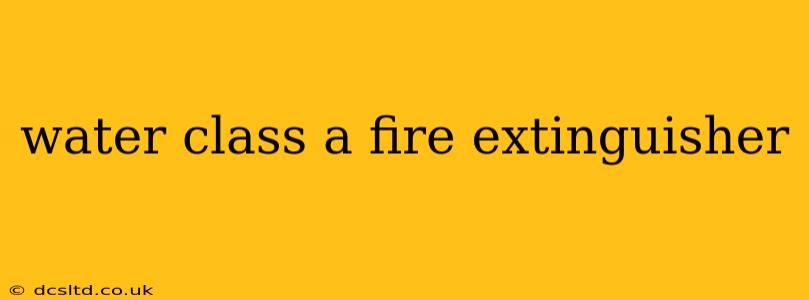Water is a fundamental element in firefighting, particularly when dealing with Class A fires. These fires involve ordinary combustible materials like wood, paper, cloth, and plastics – materials that readily ignite and burn. Understanding the capabilities and limitations of water-based Class A fire extinguishers is crucial for effective fire safety. This comprehensive guide will explore everything you need to know about these essential fire suppression tools.
What is a Class A Fire Extinguisher?
A Class A fire extinguisher is specifically designed to combat Class A fires. These extinguishers primarily use water, sometimes with additives to improve their extinguishing properties, as their extinguishing agent. The water's effectiveness stems from its ability to cool the burning material below its ignition temperature, thus stopping the combustion process. You'll often see a Class A rating indicated by a triangle symbol on the extinguisher. The higher the rating number within the triangle, the greater the extinguisher's capacity.
How Does a Water Class A Fire Extinguisher Work?
The pressurized water within the extinguisher is discharged as a fine spray or jet, depending on the nozzle type. The spray pattern maximizes surface area contact with the burning material, promoting rapid cooling. The water absorbs heat, converting it into steam, further assisting in suppressing the flames.
What are the Advantages of Using a Water Class A Fire Extinguisher?
- Cost-effective: Water is an inexpensive and readily available extinguishing agent.
- Environmentally friendly: Water is a naturally occurring substance and generally considered environmentally benign.
- Effective on Class A fires: It's highly effective at cooling and extinguishing fires involving ordinary combustible materials.
What are the Disadvantages of Using a Water Class A Fire Extinguisher?
- Ineffective on other fire classes: Water is not suitable for Class B (flammable liquids), Class C (energized electrical equipment), or Class D (combustible metals) fires. Using water on these types of fires can be extremely dangerous and potentially worsen the situation.
- Can cause water damage: Using a water extinguisher can lead to significant water damage to property.
- Conductivity: Water conducts electricity, making it hazardous to use on electrical fires.
What types of fires can a water fire extinguisher put out?
Water fire extinguishers are highly effective against Class A fires involving ordinary combustibles like wood, paper, cloth, and some plastics. However, they should never be used on flammable liquids, gases, or electrical fires.
What are the different types of water fire extinguishers?
There are various types, primarily differing in their pressure systems (stored pressure or cartridge operated) and the additives used to enhance their performance, such as wetting agents to improve penetration. The specific type will affect the range and spray pattern.
How to use a water fire extinguisher safely?
Always remember the PASS method: Pull the pin, Aim at the base of the fire, Squeeze the lever, and Sweep from side to side. Maintain a safe distance, and if the fire isn't quickly controlled, evacuate the area and call emergency services immediately.
How often should a water fire extinguisher be inspected and serviced?
Regular inspection and servicing are vital. Check your local fire codes for specific regulations, but generally, annual inspections and maintenance by a qualified technician are recommended to ensure the extinguisher remains in optimal working condition.
Can I refill a water fire extinguisher myself?
Generally, no. Refilling should only be done by trained professionals to ensure the extinguisher is correctly pressurized and functioning safely. Attempting to refill it yourself could be dangerous.
This comprehensive guide aims to equip you with the knowledge necessary to understand and utilize water Class A fire extinguishers effectively and safely. Remember that fire safety is paramount, and understanding the limitations of different extinguisher types is crucial in preventing injuries and property damage. Always prioritize your safety and seek professional help when dealing with any fire situation beyond your capabilities.
